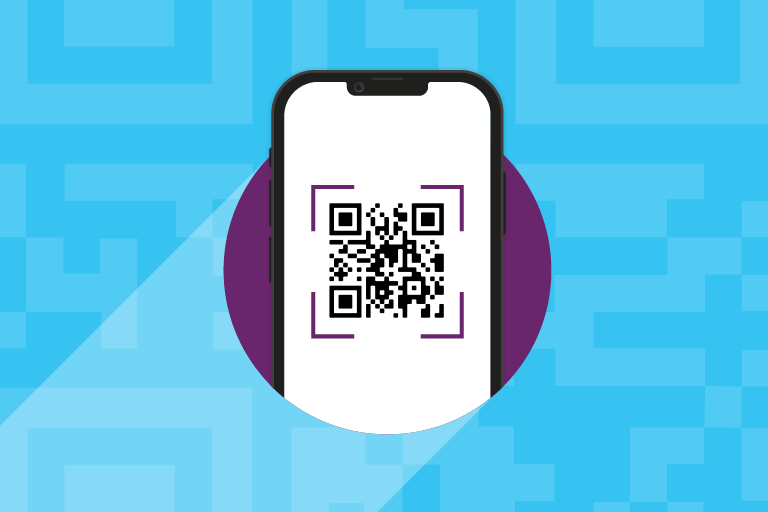A QR code, short for quick response code, is a type of barcode. Typically, QR codes are small squares containing pixelated black squares against a white background. These pixelated codes contain information that can range from the tracking number of a product to an event invitation to a restaurant wine list.
Developed by Japanese auto company Denso Wave in 1994, QR codes differ from regular barcodes because they can store much more information and can also be read faster. Unlike traditional barcodes, QR codes can be read from both top to bottom and side to side. They can also contain thousands of characters, including numbers and punctuation.
These codes have really taken off in the smartphone era because millions of people are now walking around with the equivalent of a barcode scanner in their pockets. They’ve also answered the post-pandemic need for more touch-free methods of communication.
With the rise in their usage post-pandemic, let’s take a moment to dive into how QR codes work, how they’re used, and maybe even see some of their benefits for marketers moving forward.
How do QR Codes Work?
Like other barcodes, reading a QR code is fairly simple: a user scans the image with a sensor (such as a smartphone camera or a special app) to read the pixelated image. The information they access might take them to a specific webpage or PDF or provide them with your brand’s contact information—it’s up to you!
There are two types of QR codes: static and dynamic. A static code can’t be changed once it’s been created. It’s best used for sharing information you don’t expect to change such as an email address. Dynamic codes can be regularly updated without needing to change the code itself. These QR codes don’t store the actual data, but direct the user elsewhere such as to a webpage or a PDF.
How are QR Codes Used in Marketing?
QR codes are still used to track products and product information in manufacturing, but they also have countless consumer-facing uses, too, including in marketing campaigns. They’ve especially taken off in restaurants because they give eateries the flexibility to update prices and menu items on the fly. While the options are nearly endless for how QR codes can be used, some common marketing uses include:
1. Linking to a portfolio or visual marketing items
A QR code on a business card or print marketing product can drive people to multimedia materials such as video or a portfolio of additional work.
2. Driving traffic to a website
A QR code is an easy way to direct traffic from print materials to your website without the need for someone to type in a web address. They can also be used to encourage people to download your app or join your mailing list.
3. Boosting social media following
QR codes can be set up to take users directly to your social media pages where they can immediately like or follow your page. You can also create one landing page listing all your social media accounts. (Check out the header image on this blog post.)
4. Sharing coupons and discounts
QR codes can be used to post coupons or discounts through print ads, social media, product displays or direct mail flyers. QR code coupons can be a great way to attract new customers without them needing to remember to cut out and carry a coupon with them or remember a discount code.
5. Asking for feedback
Reviews and surveys provide valuable feedback and can help companies gain new customers. QR codes that take users directly to your survey or review site can easily be added to receipts, signage, menus, or product packaging.
6. Providing more product information
You can’t always fit all the information you’d like on print materials—at least without making them overly cluttered. QR codes are a perfect way to direct users to additional information that can easily be updated, or enable them to watch a video or see more photos of the product.
7. Enhancing events
QR codes are a natural way to promote virtual versions of events. For in-person events, they can be a way to include e-tickets, maps, documents, and anything else people will need.
QR Codes in Retail
QR codes are especially helpful in bridging the gap between digital and physical when it comes to retail. While shopping, customers can use QR codes to gather more product information, add the product to their digital shopping carts, or even get digital coupons. Let’s take that second example—adding products to digital carts—and expand on it a bit.
Say a customer is browsing products in-store and likes a certain item but isn’t quite ready to purchase in store. Maybe they don’t have a way to get the item home, maybe they don’t have the money at the moment, etc. Whatever the case may be, you, as the brand, still want to capture this customer’s intent to buy this item. By putting a QR code near the item that, when scanned, opens your brand’s mobile app on the customer’s phone and adds the item to their cart or wishlist, you’re creating an event—you’re collecting data. Now, when the customer leaves the store you can still send marketing communications based on that event.
Adding a QR code to product displays is a way to help translate physical in-store actions into digital triggers that result in highly personalized marketing communications.
How to Use QR Codes in Cross-Channel Marketing
QR codes can be a great addition to a cross-channel marketing campaign. They provide a bridge between digital and physical marketing materials and can be created with different colors and shapes to cement your brand across multiple platforms. They also work well to guide customers between mediums—like using a postcard with a QR code to direct customers to download your mobile app. QR codes can also be displayed on your app or website and scanned at a point-of-sale in your brand’s retail locations.
QR codes also are very helpful to track the success of your marketing campaigns across different media. The data is tracked in real-time and can be tied to a tracking link to let you know how many conversions are being driven by your QR code.
By incorporating QR codes within your cross-channel marketing campaigns, you’ll be able to easily track customers as they travel between marketing channels, and understand the success of each channel in engaging and converting your customers. Using a cross-channel customer communication platform like Iterable, you can effortlessly set up cross-channel campaigns that integrate both print and digital mediums, engaging with each customer through a personalized marketing workflow based on their preferences to optimize the chances of conversion.






























